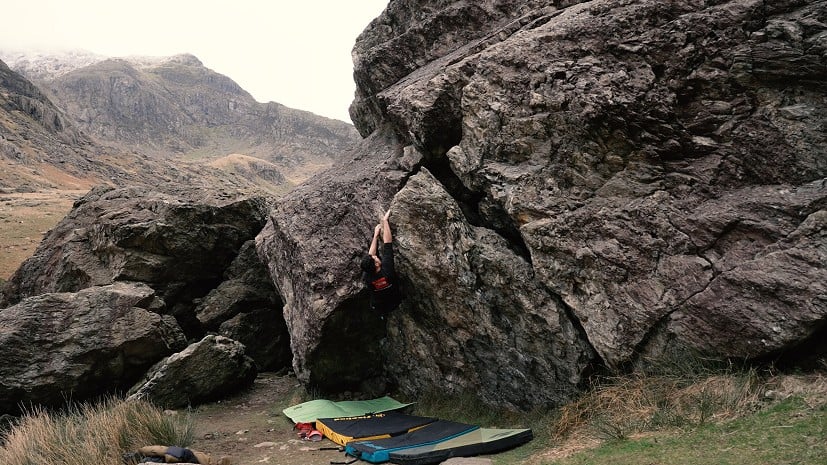
Tom Newberry shares some ideas for cooler summer bouldering spots around the UK...
As the Northern Axis tilts closer to the sun, the days are long and warm and sunny weather ensues. The summer season usually brings about a low point in television viewing as the masses head outside to explore the amazing coastlines, moorlands and mountains the UK has to offer. But not everyone looks forward to summer! Climbing becomes harder when the temperatures increase, lacking that little bit of magic you get in cold, crisp conditions that means appalling holds suddenly stick. So, for the diehard boulderer, the rise in temperature often marks the start of the off season.
With the gritstone lacking its trademark Velcro friction and the limestone caves condensed, projects are postponed and visits to many of the UK's best bouldering venues put on hold. In order to keep fingers strong and cores tight, summer forces many to head to the high Alpine granite, migrate south of the equator or even don a harness. However, for those who won't be able to fasten their seatbelts and take off, why not check out the plethora of potential still to be unlocked closer to home? Bouldering in summer and still pushing your grade are achievable - you just have to choose your venue wisely.
Fortunately, variety is something the UK does well. Whilst summer marks the end of the season for certain escarpments it also marks the start for a number of quality crags, which come out of hibernation and into condition. Those bitterly cold, green, north facing venues that dry out in the long sunny daylight hours remain cool enough to offer the sought-after friction. Those coastal crags that require calm swell to allow the steep, shaded caves to dry out in the constant sea breeze. Those high-altitude crags that need enough hours of daylight to make the long trek in and out and still have enough time for an arm-busting session. So, where are these crags? Which ones should not be missed? What is the beta?
Queens Crag, Northumberland
In the shadow of Hadrian's Wall lies the underrated and lesser-visited Queen's Crag. Wet and green throughout the winter months, the proud lines of Queen's come into condition towards the end of May. The north-facing aspect means the impeccable sculpted sandstone can often be enjoyed in good conditions, even on the warmest of summer days. Those that have been will agree that the best blocs here should be on every aspiring boulderers' ticklist. Striking highball lines and burly moves in a wild and lonely setting will be the order of the day. A team hit is definitely recommended, as more pads, spotters and banter will help when gripped on the top-outs. With the likes of Dan Varian responsible for establishing most of the modern classics, it is no surprise that many of the problems are as hard to break as the Roman defensive fortification.
Sampson's Stones, Lake District
Located on the eastern slopes of England's highest peak, Scafell, the higher altitude provides cooler, more reliable summer conditions. To the stereotypical boulderer, an 80-minute approach may sound monstrous but I'd argue that this simply adds to the experience, allowing you to really appreciate one of the most spectacular bouldering locations in the country. After negotiating your way around the final col, you'll spot the collection of huge metamorphosed volcanic rock in an almost alpine meadow setting, home to an exceptional and compact circuit made up of subtle, sequencey and gymnastic problems. A little discipline will go a long way. If you can contain the psyche, take 10 to refuel before you unleash the beast.
Coniston Bouldering, Lake District
The boulder field at the base of one of Britain's best multi-pitch mountain crags has fallen under the gaze of the more adventurous boulderer. At 620m APSL, the sublime mountain bouldering is accessed via a long but easy-going walk-in along a well-trodden bridleway. Several small areas make up the Dow Crag Circuit, which offer varied and plentiful classics. Wandering around, it doesn't take long to discover that the jumble of rock provides the perfect playground of grooves, overhangs and arêtes - all with a picturesque vista. Finish your day with a dip in Goat's Water, an idyllic swimming spot.
Churnet Valley, Staffordshire
The Churnet Valley is located just south of the Peak District National Park boundary and the neighbouring Alton Towers theme park. It is home to some 600 problems across 10 different sectors distributed along the valley sides and linked by various weaving footpaths. Access issues have arisen here with some upcoming restrictions in place, so do check the UKC Logbooks before committing (Wright's Rock Area especially) and be follow good crag etiquette. Parking can be limited and is shared with walkers during the high summer season. The once-esoteric conglomerate sandstone is now probably the most established climbing area in this article. Obviously, the altitude isn't high enough to offer cool temperatures, but thanks to the aspect of many of the crags and shade from the pine, birch, beech and oak trees, you can find decent conditions during the warmer months.

Beddgelert Forest, Snowdonia
High quality boulders hidden within the sprawling mass of Beddgelert Forest - how the first ascensionists stumbled across these isolated clusters of dolerite is astonishing. While Beddgelert has long been a popular tourist destination, the more recently developed boulders seem less popular, meaning you will likely have the bouldering to yourself. The main attraction is the Boss Cuvier boulder, which rivals any boulder in North Wales. It takes a few days of fair weather to dry, and a good breeze is useful to keep the pesky midges away.
Biblins Cave, Herefordshire
A little venue with a looming, impressive and foreboding character. Summer is the only season this limestone roof is open to climbers due to hibernating bats. Powerful and gymnastic climbing is the game here; it provides the boulderer who has spent the winter hanging off that 20mm edge a chance to see if it has all paid off. So be careful if you think you can take your wall-rat mates there for a session and expect to burn them off. Well-located on the edge of the Forest of Dean, it offers both a good place to stop and break up a long drive and is a just-about-day trip-able distance for a large proportion of the country. Whilst there aren't loads of problems, most grades from V5-V15 are covered.
Hartland Quay, Devon
It is no secret that the north coast of Devon is rapidly becoming the frequented venue for summer bouldering, the wave-washed blocs now draw in more than just the keen local boulderers. Traces of chalk are a common sight when walking along the beach of Hartland Quay, which hosts some of the UK's finest coastal bouldering. Although more spread out than nearby Tintagel, the quality and rare culm geology of these blocs will make up for the lack of quantity. Its rugged cliffs and marvellous coves create a unique atmosphere for bouldering at any time of the year; however, the sea breeze, calmer swell and majestic sunsets make this an exceptional and reliable summer venue.
Tintagel North, Cornwall
The new kid on the block. Set amongst some of the Atlantic Coast's most prized adventure trad cliffs are some raw, powerful boulders. These newly-discovered blocs provide possibly the best mix of low and high-grade problems on the coast. The Arthurian legacy surrounding the area only adds to the dramatic setting and mystical atmosphere. Those who do venture down will not only earn their pasties but also discover some prized jewels from V0 to V13, including some of the finest lines in the region. Expect steep basic pulling on small in-cut holds, suiting those who train on boards - think Switzerland by the sea. Back in 2015 Tintagel was hit hard by the winter storms, which moved house-sized blocks! However, the natural reset has opened up more new problems, which has given the place a newfound popularity.
Torridon Celtic Jumble, Northwest Highlands
This 'Celtic Jumble' of hardened sandstone boulders might attract midges in the summer, but on a breezy day on a shady boulder, the Highland setting of these giant blocks by Loch Torridon at the foot of Liathach makes for a wonderful day out. The benefit of going in summer is that the perma-bog will potentially be less boggy - but it could still be worth bringing a tarpaulin (and a midge net of course) to protect your mats. The classic Malc's Arête is worth a shot for those with strength for the steepness, while Launch 4+ and Layback Arête 4+ on the Celtic Boulder are fun alternatives. Celtic Knot 6a on the Conundrum Boulder is a fun, indoor-esque challenge with a mantle and a small dyno to the top.
Fair Head Boulders, Northern Ireland
When you think of Fair Head, you probably picture world class trad, but there's some pretty epic bouldering too. Between the foot of the cliff and the water's edge lies a carpet of massive dolerite boulders stretching three miles from one end of the crag to the other. The north-facing aspect and more reliable weather make summer a good time to plan your visit. Over 450 problems on rough but not abrasive rock offer typically steep, crimpy and powerful climbing. It is worth noting that some of the landings at the Head can be bad - most problems require a minimum of two pads and some a whole lot more.
Other options
Since this list was never going to be exhaustive:
Llanberis Pass, North Wales - a popular (and busy) option in summer on the roadside Cromlech boulders and others scattered along the pass. Watch a UKC video of some circuit classics or read the associated article.
St. Bees Head, Cumbria - another popular choice if you don't mind a sandstone sun-trap with a cooling sea breeze, but expect sub-optimal conditions and some company in summer. Check access restrictions as some sections are off-limits in the summer.





















Comments